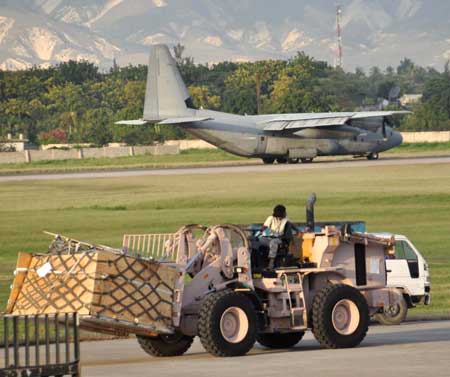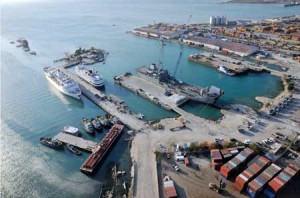In meetings during our visit to TRANSCOM spring, TRANSCOM officials explained how they addressed the Haiti mission. Three key aspects of this mission were highlighted.
First, the Haiti effort had to be conducted while the two key ongoing efforts were maintained at a high level, namely support for the Afghan surge and the Iraq drawdown.
Second, the multi-modal approach, which has become the TRANSCOM con-ops, was featured throughout in shaping various paths and methods to provide for support for the Haitian aid effort.
Third, extraction capabilities were built in from the beginning. Put in other words, TRANSCOM had an endgame strategy in support of SOUTHCOM to shift as rapidly as possible to support the NGOs, and civilian agencies to be at the heart of the reconstruction of Haiti.
Obviously, the nature of an aid effort to an earthquake ravaged country like Haiti was fluid with requirements in flux. And highlighted throughout the interview were the multiple military aid assets, which were being introduced throughout the effort, which were being inserted without much pre-planning. In effect, the multi-modal approach was a grid being placed on a fluid situation.
The effort started by setting the commander’s intent with regard to the core goals to be set by the supply effort. General McNabb set these goals in consultation with his staff while he was in Afghanistan. The earthquake hit while the Commander was in his primary area of current activity, namely the support for the Afghan troop surge. The goal was to be able to deliver a minimum of 250 Ton Equivalent Units or TEUs per day with a minimum of 100 of these being meal-ready-to-eat or MREs and 100 of these being water with 50 of these being for other needs.
To do this, it was necessary to establish an air bridge, a sea bridge and a land bridge from the Dominican Republic. And at the heart of this effort was the need to open up the seaport as rapidly as possible given the centrality of shipping by sea to provide the tonnage necessary to get in adequate supplies.

Earlier on this website we provided information on the air bridge operations through an interview with General Burke and with regard to the sea basing operations through an interview with Jim Strock. And we provided information with regard to the continuing USCG role in Haiti in the interview with Admiral Branham.
But what the TRANSCOM interview provided was a unique view on the need to balance this effort with the Afghan supply effort as well as the endgame strategy.

With regard to balancing the effort, Operation Unified Response led to a higher sortie generation rate by AMC and by the various commands engaged in the effort. But the sortie generation rate necessary to support Afghanistan was clearly maintained.
With regard to the endgame of insertion and withdrawal built-in to the initial considerations, the role of the commercial sector was crucial. A decision was made at the outset to insert a military Joint Logistics Over-the-Shore (JLOTS) capability but at the same time build a commercial JLOTS capability in order to maximize an ability to provide supplies in the badly damaged port.
A key element of this effort was the use of a commercial contract with Crowley to provide for the commercial JLOTS. This contract allowed Crowley to support the assessment of damage effort for the port and to insert capability throughout January into February in support of the re-supply effort. This meant that substantial sea support was ramped up rapidly, and that the role of commercial support could be rapidly enhanced as the military withdrew.
A final aspect to highlight from the TRANSCOM effort is the diversity of means used to shape a maritime resupply effort. TRANSCOM was able to tap Army Landing Craft Utility Vehicles, shaped a new con-ops in using Army watercraft, used a high-speed vessel which was in receivership and ported in Florida, and generally able to tap USMC and USN seabasing capabilities. But again by relying simultaneously on the commercial sector such as the case with Crowley Marine, TRANSCOM was able to prepare for withdrawal as military support capabilities were inserted in Operation Unified Response.
———-
***Posted On August 8th, 2010

